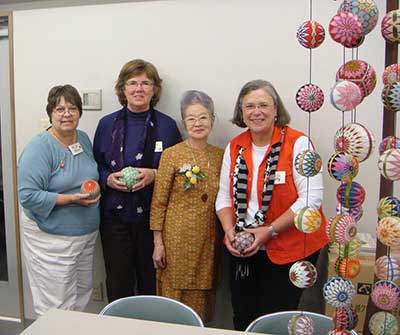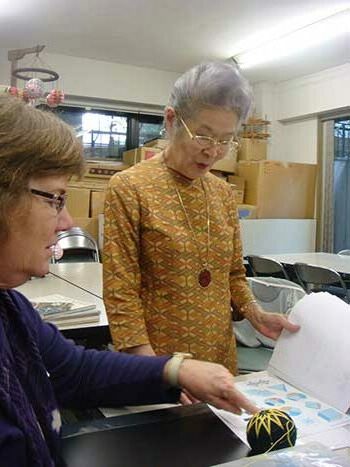Membership in the JTA and Techniques Certification by the Japan Temari Association
In late June of each year, JTA judges gather to evaluate students’ work and award certification at one of four levels. We work with the head of the international group of JTA members (Chidori Temari Group) throughout the year to prepare temari and patterns to submit for judging.
Barb is retired from assisting students through the certification process. Anyone can still take her online courses and enjoy them without pursuing certification through the JTA. If you’d like to pursue certification, contact Barb to find a sponsor.


Level 1 Basic (Honka) Certification
Good execution of stitching is the important thing about this level. You can apply for this level after one year of temari study, having successfully mastered techniques learned in Barb’s Level 1 course. By this time, you will have completed 20 – 30 temari. You can apply for levels 1 and 2 at the same time (if you have completed both courses or have equivalent experience). When applying for Level 1, you submit one photo of superior quality for each:
- Simple 4 division temari stitched in squares (shikaku).
- Simple 6 division temari stitched in tri-wing or trefoil (mitsubane-kikkou kagari).
- Simple 8 division temari stitched in merry-go-round (jyouge douji kagari).
- Simple 12 division temari stitched in kiku herringbone (uwagake chidori kagari).
Level 2 Advanced (Koutouka) Certification
For Level 2, excellent stitching quality is important as well as being able to communicate to someone else how you stitched the temari in your pattern. You should have completed 40 -50 temari before applying for L2. Using current JTA vocabulary is very important. All patterns are written in English using popular translations used by most temari stitchers. The JTA does not require you to write in Japanese. The temari designs do not have to be your original work, so only your technical proficiency is judged, not design. You can learn the many skills for making these more advanced temari and learn how to write patterns using JTA vocabulary in Barb’s Level 2 course. Learning to write patterns is also very important in keeping a notebook of your stitching, with directions, diagrams, and photographs. When applying for Level 2, you submit photos of superior quality and written directions (in English) with diagrams for:
- Three combination 8 division temari
- Three combination 10 division temari
New in 2016: The judges look at your photo and diagram. They see the English text and rely on your teacher’s recommendation that it is worthy of passing. Your pattern text will not be translated into Japanese.
Level 3 Teacher (Shihan) Certification
This is one of the most challenging levels and may be applied for two years after receiving Level 2 certification. You are required to design eight original temari and write the patterns. Since upon successful completion, the JTA will certify you as a teacher, you should submit temari that demonstrate a wide range of divisions, markings, and stitching techniques, with intricate and more challenging designs. Three of the temari you make are mailed to the JTA for them to keep and use as examples and for sale to support the organization. Or you can request to have them mailed back to you.
Level 4 Master (Kyoujyu) Certification
Six original temari and patterns should be submitted for the JTA to keep. All work needs to be of superior quality. You can apply for this level three years after receiving Level 3 certification. When you apply for this level, you work directly with the head of the JTA Chidori Temari group (for international students).
FAQs
FAQs about the JTA Temari Courses
1. How long does each course last?
However long you want! They are self-paced. I used to run these classes in an online group and give out one lesson per month. So you can expect it to take you six months to complete each course.
2. When and how do I sign up?
Click on the Etsy link under the course you choose and purchase the class through Etsy. Etsy will immediately send you a link to download the pdf (course text). Please be aware that lessons are progressive. You will need to start with the first lesson of the course. Each course builds upon the previous one. If you are an experienced temari maker, you are welcome to take whichever course appeals to you. Yes, you can take both levels at the same time if you are an avid stitcher!
3. Is there a kit supplied with the course?
No. The required text for these courses is the book Temari Techniques. Hard copies are available on Amazon.
The first lesson is all about supplies, where to get them, and how to make the ball. It’s covered in my book Temari Techniques and I will add more information about this topic in the class text. There is no need to get a head start on purchasing supplies. I would estimate the cost of materials to be around $15 to $20.
4. Do students have to join the JTA and go through the certification judging?
No. Only if they choose! Most students take these courses to learn and expand their temari-making skills without joining. Those who want an extra challenge and those who want to become certified teachers will have the opportunity to join the JTA and apply for certification. When you decide you want to apply for certification, contact me, and I will help you find a sponsor.
5. I'm an experienced temari stitcher. Which course should I take?
Look at the techniques taught in each course. Remember that I will be teaching new patterns from the JTA temari books for each technique.
FAQs about the Japan Temari Association
1. What is the Japan Temari Association (JTA)?
JTA is an organization of temari makers that was founded in 1979 with headquarters in Tokyo, Japan.
2. Who can join?
Anyone! If you are living in Japan and studying with a JTA-certified teacher, you will have the opportunity to join through your teacher. A few years ago, international students were invited to join and participate in the certification process through a liaison with Ai M. from Kobe, Japan. She now leads a growing international membership and is head of the JTA Chidori group for international temari makers. Ai works with Level 3 and Level 4 members. They, in turn, work with Level 1 and Level 2 and then pass the certification work of their students to Ai for translation and sending to the certification judges.
3. Why join the JTA?
Most people join because they want to learn everything about temari they can. They care about the art and want to support the organization promoting and preserving it. The certification process is a learning experience in itself. It takes a self-motivated, talented stitcher to gain the skills necessary to pass the different levels of certification. Who better to learn from than the JTA?
4. What time of year do memberships start?
Memberships run from April 1 – March 31 of each year.
5. How much are the dues?
The dues are minimal, assessed per year. Your sponsor will tell you the amount and what you receive as a member.
6. What is the timeline for the certification process?
Courses for learning temari run year-round. Judging for certification takes place in June of each year. Generally, students begin thinking about certification the year before they apply and seriously settle down to work in January of that year.
7. Who is the JTA contact working with international members?
Ai M., Shibu-cho, and head of the JTA Chidori Temari Group.

